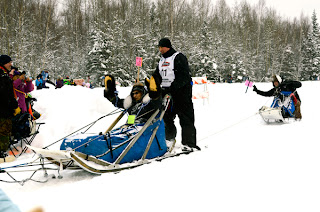 |
| Sam's Analysis |
Each day in a rural Alaska face book, a lady runs a trivia question on the Iditarod, now that’s the Spirit.
Day 2 of the Iditarod, and the mushers are moving. Yesterday, we thought the mushers never go a 100 miles and I was busy doing the math. I know there was a rest period included in these jaunts so it seems it was not a steady run without a little rest. As I write this blog, the mushers are entering Rohn and John Baker is in that top group approaching Rohn.
When the lead mushers arrived in Rainy Pass today, a “gentle snow” started falling on them and it got thicker as the other mushers checked into Rainy. Everyone was complimenting the trail committee for the well groomed trail, and the speed of travel is indicative of this. I completely missed the arrival time into Rohn and am scratching my head on that one, but it does indicate a longer rest was taken not all at once but packed into the last three checkpoints. What happens in Rohn will be the one item to watch with regards to rest time, and there is going to be some eye staring, restless naps, when and who makes the first move to Nikolai, and the abundance of dog teams congregating in Rohn. This will make any contender uneasy to see such a large field at this stage of the race.
Word has it that Ramey Smyth may have fell asleep than fell off his sled and lost his team which cost him some time. His team was secured by Rohn Buser. Ramey may have had some help from Jeff King to reach Ramey’s team which is allowed in the race. We hope that this is just an embarrassment and has no bearing on Ramey’s chances to win the race. We stress that the Iditarod is now a game of inches and those “inches” take a more significant effect on chances to win the race.
I have not heard from anyone on the toll the snow falling at Rainy has on any of the mushers. Light snow falling still necessitates more energy consumption by the dog teams which means more time tending to the dogs’ feeding. It was encouraging to see Dee Dee Jonrowe come into Rainy Pass with her dogs still barking. I am amazed at the quality of dog running the Iditarod today. This is a good time to mention the vet check and screening that was done in Anchorage to make sure the dogs are fit to run the race. More advances have been made by the Iditarod Race with regard to dog endurance that any other endurance dog sport, and these advances have been used in the rest of the dog world. Now people know one of the reasons Vets follow the race as it is a nice laboratory to learn of all these advances being applied in the field.
Tonight, we follow the mushers as they set up for the run to Nikolai. There will be a short break from abundance of snow but not for long as deep snow is still the mantra on the approach to the 24 hour. If we look at the top 20 going into the 24 hour, will we notice a changing of the guard with the younger mushers occupying most of the slots? Take note of that, and make your own judgement. The other item to look for is the number of mushers congregated going into the 24 hour, meaning separation of the top ten teams by only 2 hours and the top 20 by 4-5 hours. I noticed this trend in the mid distance races and it could still be happening in the early part of the race.
We can expect more separation on the runs from Takotna to Ruby as has traditionally happened. Also by Galena, we can almost define a contending field. As mentioned before, this is a race done in segments but with common traits on strategy. We have not seen a team “stove up” in the modern Iditarod- where the dogs just refuse to continue running. This has happened in early Iditarods but not in the modern era. When you listen to interviews at Ruby, you will hear that mushers want to have their dogs rest so they can maintain speeds. This is why people are amazed when they see the leaders push their teams to the extreme without any “stoving “ happening. This is another example of the advances the Iditarod dog has made with regard to long distance racing.
Tonight, we see our last day of good action until we rest up for the 24 hour. We want to know the moves each team makes and whether it affects them for the run to Ruby.
Sam Towarak, retired school teacher, dog musher, and sports commentator, lives in Unalakleet, Alaska.





